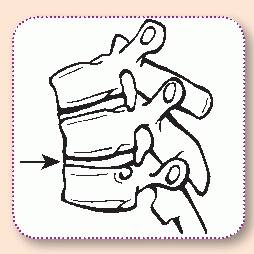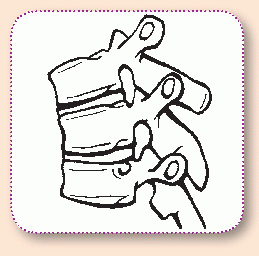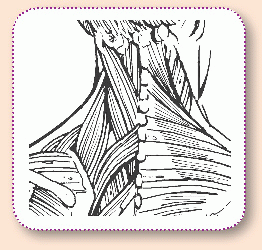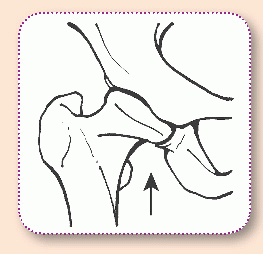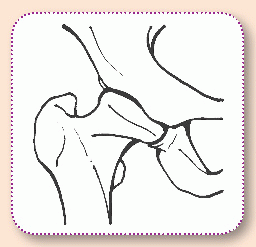Patient Information Sheets
Monica O. Ferguson
Lumbar Disk Herniation
Monica O. Ferguson
|
What Is Lumbar Disk Herniation?
The spine is made up of bones, called vertebrae, with a disk in between each vertebra that provides cushioning. The lumbar spine is the name for the group of five vertebrae that make up your lower back. In a disk herniation, the disk slips out of place and can push on a nerve in the spine. This is usually caused by a wearing down of the disk, or degeneration, as we age.
What Are The Symptoms?
Pain in the lower back
Pain may travel down the buttocks and into one or both legs.
Numbness or tingling going down the leg
Leg weakness
How Is It Treated?
A couple of days of rest may be helpful for severe pain, but prolonged rest is not recommended.
Anti-inflammatory medication, like ibuprofen or naproxen. Talk to your doctor before using this type of medication.
Pain medication such as acetaminophen (Tylenol)
Stronger pain medications, such as narcotics, are sometimes used for a short period of time.
Steroid injection. This is done under x-ray guidance to direct the medication to the right place.
Physical therapy
Surgery to remove the disk
When Can I Expect To Feel Better?
You should start feeling better after a few weeks of treatment.
Warning Signs To Contact Your Doctor Immediately:
Loss of bowel or bladder control
Numbness in the groin or genital area
Cervical Degenerative Joint Disease
|
What Is Cervical Degenerative Joint Disease?
Cervical degenerative joint disease is another name for osteoarthritis affecting the neck. Osteoarthritis is a “wear and tear” form of arthritis that results from our bones deteriorating, or wearing down, as we age.
What Are The Symptoms?
Neck pain
Neck stiffness
Headache, especially in the back of the head
Numbness or weakness in the arms, hands, and even the legs
Symptoms may be worse when upright from supporting the head
How Is It Treated?
Rest. Wearing a soft cervical collar may help, but it should not be worn all the time.
Pain medication such as acetaminophen (Tylenol).
Anti-inflammatory medication, like ibuprofen or naproxen. Talk to your doctor before using this type of medication.
Physical therapy, which may include hot or cold treatments, massage, and exercises
When Can I Expect To Feel Better?
Symptoms should improve after a few weeks of treatment but may flare again without warning.
Cervical Muscle Strain
|
What Is Cervical Muscle Strain?
Cervical muscle strain is a sprain in the muscles of the neck. It is usually caused by a sudden, unexpected movement that causes the neck to extend and flex, often to an extreme position. It may also be caused by holding the neck in the same position for a long time. It may be accompanied by a sprain of the ligaments in the neck. Ligaments are slightly elastic bands of tissue that connect bones to other bones, holding them in place.
What Are The Symptoms?
Pain in the back of the neck
Pain is often worse a day or two after the injury.
Neck stiffness
Headache, especially in the back of the head
Numbness in the arm or hand
How Is It Treated?
Ice may help for the first few days. Apply for 20 minutes, three or four times a day.
Anti-inflammatory medication, like ibuprofen or naproxen. Talk to your doctor before using this type of medication.
Muscle relaxants
A soft cervical collar can be used initially to support the head, allowing the neck muscles to rest. However, prolonged use should be avoided, as it can lead to neck stiffness.
Stretching exercises
Physical therapy
When Can I Expect To Feel Better?
You should improve after 4 to 6 weeks of treatment.
It may take months to recover following a more severe injury.
Warning Signs To Contact Your Doctor:
Persistent numbness or weakness in the arm or hand
Worsening symptoms after the first few days
Lack of improvement
Hip Degenerative Joint Disease
|
What Is Hip Degenerative Joint Disease?
Hip degenerative joint disease is another name for osteoarthritis affecting the hip. Osteoarthritis is a “wear and tear” form of arthritis that results from our bones deteriorating, or wearing down, as we age.
What Are The Symptoms?
Pain in the buttock, groin, or thigh
Pain is usually worse with activities and improves with rest
Stiffness of the hip
Walking with a limp
How Is It Treated?
Weight loss
Changing your activities. You may need to avoid certain activities that make your pain worse.
Physical therapy. Aquatic exercises can be particularly helpful.
Pain medication such as acetaminophen (Tylenol)
Anti-inflammatory medication, like ibuprofen or naproxen. Talk to your doctor before using this type of medication.
Surgery to replace the hip
When Can I Expect To Feel Better?
Symptoms should improve after a few weeks of treatment but may flare again without warning.
Trochanteric Bursitis
|
What Is Trochanteric Bursitis?
Trochanteric bursitis is an inflammation of the bursa in the hip. A bursa is a fluid-filled sac that cushions a joint.
What Are The Symptoms?
Pain affecting the side of the hip
The pain is often worse with lying on the hip or with prolonged activities such as walking or running.
How Is It Treated?
Rest. Avoid activities that make the pain worse.
Anti-inflammatory medications, like ibuprofen or naproxen. Talk to your doctor before using this type of medication.
Icing the area, if the bursitis was caused by an injury
A steroid injection into the bursa
Some patients find physical therapy to be helpful.
Surgery is very rarely necessary.
When Can I Expect To Feel Better?
You should start feeling better with treatment after a few days, but it can take up to 6 weeks to fully recover.
Following an injection, the pain may be immediately relieved and then return after several hours, once the local anesthetic wears off. The steroid should start relieving the pain after a couple of days.
Low Back Pain
|
What Is Low Back Pain?
Low back pain refers to pain affecting the lumbar spine, which is a group of five bones in the lower back. It is usually caused by a strain of the muscles or a sprain of the ligaments and tendons that surround the lumbar spine. It may also be related to the disks between the bones and the nerves that come out of the spine.
What Are The Symptoms?
Sharp or dull pain in the lower back
Pain may be worse with movement, especially bending or lifting.
Stiffness is often present.
Numbness going down one or both legs
How Is It Treated?
A couple of days of rest may be helpful for severe pain, but prolonged rest is not recommended.
Pain medication such as acetaminophen (Tylenol)
Anti-inflammatory medication, like ibuprofen or naproxen. Talk to your doctor before using this type of medication.
Stronger pain medications, such as narcotics, are sometimes used for the first few days.
Heat or ice
Muscle relaxants
Stretching and strengthening exercises
Physical therapy
When Can I Expect To Feel Better?
An acute episode of back pain will usually improve significantly after a few days but will often take 4 to 6 weeks to improve completely.
Low back pain may become chronic and last for years.
Stay updated, free articles. Join our Telegram channel

Full access? Get Clinical Tree


